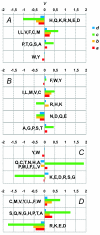Molecular evolution of the hyperthermophilic archaea of the Pyrococcus genus: analysis of adaptation to different environmental conditions
- PMID: 20042074
- PMCID: PMC2816203
- DOI: 10.1186/1471-2164-10-639
Molecular evolution of the hyperthermophilic archaea of the Pyrococcus genus: analysis of adaptation to different environmental conditions
Abstract
Background: Prokaryotic microorganisms are able to survive and proliferate in severe environmental conditions. The increasing number of complete sequences of prokaryotic genomes has provided the basis for studying the molecular mechanisms of their adaptation at the genomic level. We apply here a computer-based approach to compare the genomes and proteomes from P. furiosus, P. horikoshii, and P. abyssi to identify features of their molecular evolution related to adaptation strategy to diverse environmental conditions.
Results: Phylogenetic analysis of rRNA genes from 26 Pyrococcus strains suggested that the divergence of P. furiosus, P. horikoshii and P. abyssi might have occurred from ancestral deep-sea organisms. It was demonstrated that the function of genes that have been subject to positive Darwinian selection is closely related to abiotic and biotic conditions to which archaea managed to become adapted. Divergence of the P. furiosus archaea might have been due to loss of some genes involved in cell motility or signal transduction, and/or to evolution under positive selection of the genes for translation machinery. In the course of P. horikoshii divergence, positive selection was found to operate mainly on the transcription machinery; divergence of P. abyssi was related with positive selection for the genes mainly involved in inorganic ion transport. Analysis of radical amino acid replacement rate in evolving P. furiosus, P. horikoshii and P. abyssi showed that the fixation rate was higher for radical substitutions relative to the volume of amino acid side-chain.
Conclusions: The current results give due credit to the important role of hydrostatic pressure as a cause of variability in the P. furiosus, P. horikoshii and P. abyssi genomes evolving in different habitats. Nevertheless, adaptation to pressure does not appear to be the sole factor ensuring adaptation to environment. For example, at the stage of the divergence of P. horikoshii and P. abyssi, an essential evolutionary role may be assigned to changes in the trophic chain, namely, acquisition of a consumer status at a high (P. horikoshii) or low level (P. abyssi).
Figures





References
-
- Robb FT, Maeder DL, Brown JR, DiRuggiero J, Stump MD, Yeh RK, Weiss RB, Dunn DM. Genomic sequence of hyperthermophile, Pyrococcus furiosus: implications for physiology and enzymology. Methods Enzymol. 2001;330:134–157. full_text. - PubMed
-
- Kawarabayasi Y, Sawada M, Horikawa H, Haikawa Y, Hino Y, Yamamoto S, Sekine M, Baba S, Kosugi H, Hosoyama A, Nagai Y, Sakai M, Ogura K, Otsuka R, Nakazawa H, Takamiya M, Ohfuku Y, Funahashi T, Tanaka T, Kudoh Y, Yamazaki J, Kushida N, Oguchi A, Aoki K, Kikuchi H. Complete sequence and gene organization of the genome of a hyper-thermophilic archaebacterium, Pyrococcus horikoshii OT3. DNA Res. 1998;5:55–76. doi: 10.1093/dnares/5.2.55. - DOI - PubMed
Publication types
MeSH terms
Substances
LinkOut - more resources
Full Text Sources

